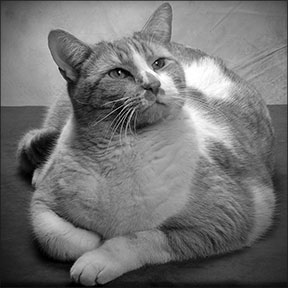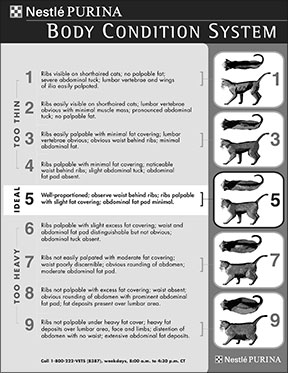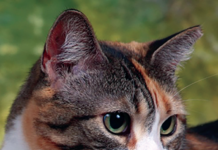Veterinarians classify 54 percent of cats in the U.S. as overweight or obese, according to a study by the Association for Pet Obesity Prevention. That’s about one in two cats or about 47 million. The association calls the situation — without irony — an “expanding epidemic.”

But it’s no laughing matter. Excess weight diminishes a cat’s quality of life. It’s hard on arthritic joints and can lead to liver problems, diabetes and cancer, says Joseph Wakshlag, DVM, Ph.D., Associate Professor of Nutrition at the Cornell University College of Veterinary Medicine.
Q. How do you define overweight or obese, Dr. Wakshlag?
A. Cats should remain in the four-to-five range on the Purina Body Condition System (on Page 7). As they age, a score of five is better, and five-and-a-half isn’t so bad, but you don’t want to get above that. Obese is eight or nine. Cats tend to gain weight and maintain that overweight or obese status since fat tissue is not very metabolically active. Cats tend to not be as active when obese, so you really need to cut calories to get weight loss.
Q. What is the best way to keep pounds off?
A. Understand the body condition scoring system. Don’t feed according to what the food bag says. Typically, what a kitten is eating at around 4 months of age is about the amount that the cat will need as an adult.
Q. Are therapeutic weight-loss diets — the kind you buy at the veterinary clinic — healthy?
A. All the therapeutic foods designed for weight loss are healthy and cats can stay on them for years if needed.
Q. What’s the best way for cats to lose weight?
A. We can do aggressive weight loss with therapeutic foods formulated to have extra vitamins and minerals so they are getting what they need. When I go to the supermarket and get a “light” formula and give only 60 percent of what it says to give, I can potentially shortchange that cat on vitamins and minerals. That’s why we recommend therapeutic diets. They help with satiety and have a higher protein-to-calorie ratio as well as carnitine (a substance that helps the body turn fat into energy) that may help maintain muscle mass during weight loss. They can optimize weight loss, and that’s why they are more expensive. You can get a high-protein low-calorie food from the grocery store but you risk shortchanging vitamins and minerals.
Many people make a mistake by switching brands. Let’s say they give a high-end weight-loss food although they don’t know how many calories it has. Then they switch to weight management in another brand and cut back, so the cat gets less food than before. But foods from different manufacturers have different calorie levels — there is a huge range — so unless you know the number of calories in each one, you could feed less but still give more calories. You may not be doing your cat justice.

288
Stay with the same brand or same family of products, as their weight management or “light formula” will definitely have fewer calories than the product from the same brand for adult maintenance. Most of the manufacturers list calorie counts on their website — not the bag — or you have to phone them.
Q. How do you figure out how many calories per pound to give to achieve weight loss?
A. Have your vet help with the calculation, and use the ideal body weight as a guide. Typically, you need around 20 calories per pound of body weight to maintain a cat or get slow weight loss, although that’s at rest. Let’s say my cat is 13 pounds but he should be 9. I multiply 9 by 20 calories to get the resting weight requirement, but you usually have to go lower than that to get good weight loss. This 13-pound cat needs 180 calories at a resting rate. This plan might work for a high-activity cat to lose weight, but most people have to drop it back even more.
Q. What treats are appropriate for an overweight cat?
A. Unfortunately, treats during a weight-loss plan are hard to recommend. Often we tell owners to use the kibble they are feeding as a treat. Five extra kibble are usually not a problem and can be taken from the main meal.
Q. Any parting advice?
A. From a veterinary perspective, weight gain in cats is due to the inactive and over-consumptive lifestyle of most indoor cats. Doing things to get your cat more active and making sure to feed appropriately will help with future problems. Cats who cannot groom themselves because they are too heavy can have skin issues that can become life threatening, and the risk of developing diabetes is very real in overweight cats.
Being diligent and weighing out the right amount of food every day is critical to a successful weight-loss program. Ideal weight loss is between one to two percent per week, and your veterinarian can help you track this since all therapeutic diets are not created equally. Some are high in fiber for satiety and others are not. ❖



